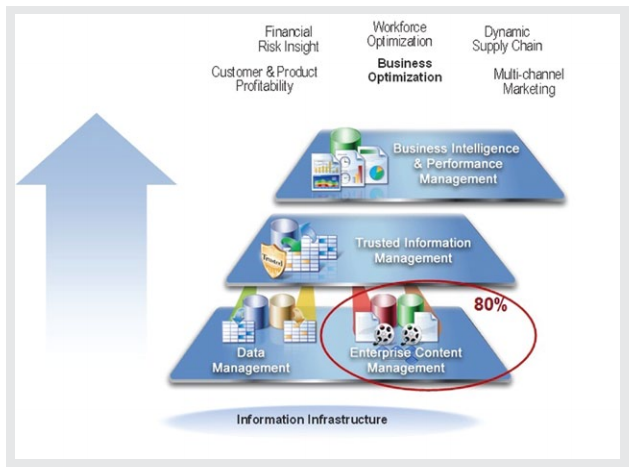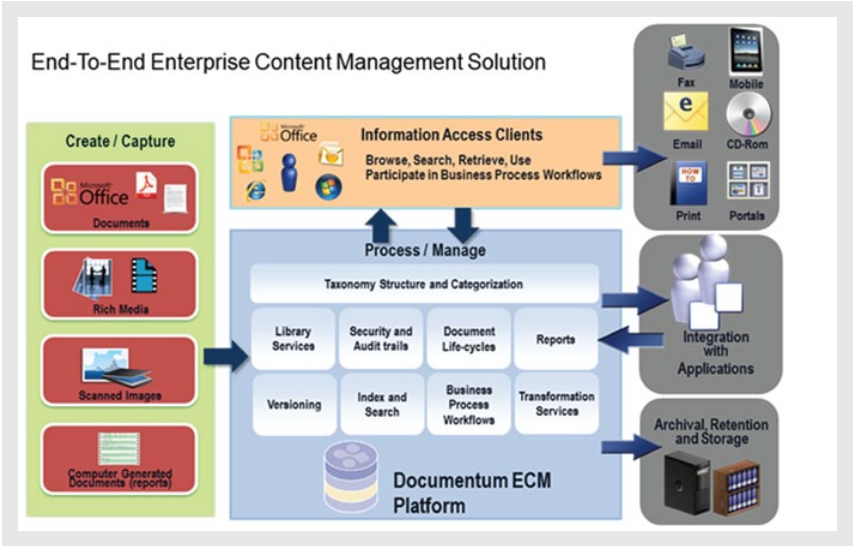OVERVIEWEnterprise Content Management (ECM) is not simply a software solution. In full meaning, ECM is the system including
strategies, methods and set of tools used to capture, manage, store and deliver all unstructured content (or information)
of an organization to users, to other applications and to business processes of the organization.
Unstructured information (includes many types such as documents, video, audio, email and reports exported from
business applications, etc.) accounts for 80% of the total information volume of an enterprise. For example, in banking
sector, unstructured information can be loan application documents, account – opening documents, L/C (Letter of
Credit), video of ATM system supervision, recorded calls of customers to Customer service center, etc. This information
makes up for a much larger portion than structured one which is stored as database in such applications as Corebanking,
Switching, card Management System, etc.

80% information of an organization is unstructured
Introduction to the solution An overall ECM solution consists of 2 main components:
Capture of unstructured information and Management
of the captured information.
Capture of unstructured information provides
functionalities as follows:- Capture: : scan documents or import files if scanning
is not required, perform online/offine, capture data
from fax server, etc.
- Classify: Captured documents can be classified
manually or automatically (the system automatically
identifies documents and “learns” taxonomy).
- Extract: information in the document can be
extracted thanks to such technologies as Optical
Character Recognition (OCR), Optical Mark Recogni-
tion (OMR), and Intelligent Character Recognition
(ICR), etc.
- Validate: Users can review and modify all the
automatically extracted information
- Delivery: Captured information and extracted
information can be imported into central repository
or other repositories.

5 basic steps in information capture
Functionalities of Information management component
for captured information:- Document management: manage versions, link
documents, manage virtual directories, etc.
- Workflow management: create workflows, monitor
and analyze the performance of process workflows.
- Preservation policy: establish preservation policies
for each type of information, ensuring compliance
with financial accounting standards.
- Lifecycle management: define a lifecycle from
“Create” stage till “Completely discard” stage, provide
automatic content transfer to difierent storage tiers
based on status of information, support compression
and anti-overlap.
- Caching mechanism: help to reduce request for
connections to the central but increase search capac-
ity and access to documents from far locations
(branches).
- Security: Authentication (AD, Tivoli, etc.) Authoriza-
tion (ACLs), Auditing (FDA 21 CFR), encryption, digital
signature, full disposal.
- Indexing and search: support users to search docu-
ments easily by simple and steps on intuitive
interface.
- Statistics report: build, consolidate and export
statistics of documents easily and quickly.

The overall ECM solution
ClientsUnstructured information exists in every enterprises and
organizations and attaches to 80% of business processes
especially paper works and documents. Therefore, ECM
solution is suitable for all organizations or enterprises to
deploy at a specific level, partially or wholly and compre-
hensively. However, for some sectors in which IT application
in operation accounts for high portion and processing
unstructured information is required and important, ECM
application becomes indispensable. For example:
- Bank and financial organizations and credit institutions.
- State and Governmental authorities.
- Telecommunications services providers.
Benefits
ECM adoption brings many benefits to enterprises and
organizations, helping to manage enterprise content
and information easily and consistently, and meeting all
standards and defined processes. In particular:
- Automate business processes.
- Centralize information management
- Provide information quickly and fully.
- Support better and timely decision-making.
- Save operation costs (especially paper costs).
- Measure work quality easily.
- Reduce mistakes and loss
- Check, search and retrieve information easily.
 Digitalizing documents and saving paper costs with ECM solution
Digitalizing documents and saving paper costs with ECM solutionOur strengths HPT is proud to be the first Information Intelligent
Group partner (IIG Partner) of OpenText – the world’s
leading supplier of Enterprise Content Management
(ECM) solutions in Vietnam. By being IIG partner, HPT
has capability to provide, consult and implement ECM
solution of OpenText in Vietnam as well as in the
region. Especially, OpenText has committed to support
HPT in training technical teams, promoting market as
well as to offer a special policy for HPT and all clients
using ECM solution provided by HPT and OpenText.
Currently, HPT has built ECM consultant teams and a
ECM deployment teams in both the North and South
of Vietnam. We have implemented successfully ECM
solutions in leading banks in Vietnam. In reality, the
solution showed it meets the highest requirements
and increases business effciency significantly as well
as improves competitiveness of clients.